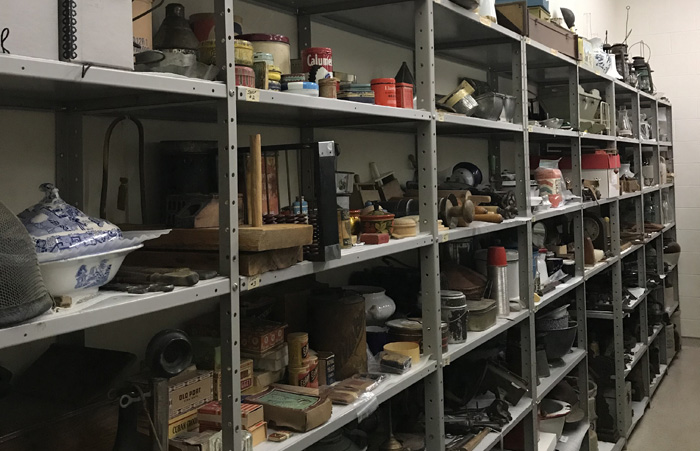You may have heard of the book “The Life-Changing Magic of Tidying Up: The Japanese Art of Decluttering and Organizing” written by Marie Kondo. The book is filled with tips and tricks to show you not only how to organize your home, but how to enjoy organizing your home. Thankfully for curators and people who work with museum collections, the joy of organizing and tidying comes naturally to us! For the past two years the curatorial department has undertaken organization or cleaning projects during the museum’s “quiet” season (although if you ask anyone who works here, there is no such thing as a “quiet” season at Mennonite Heritage Village!).
This year, our project goal is to completely clean and inventory “Row 1” of our collections storage room. That’s just the first row out of sixteen, so this will be an ongoing, long-term project. This row alone has about 1000 artefacts, out of a total of approximately 16,500! Not only will we clean and inventory these objects, but we will also ensure each artefact is stored with others of the same “type”; that is, cooking tools are stored together, children’s toys are stored together, woodworking tools are stored together… you get the idea. This is how history collections in professional museums are typically organized, and although MHV’s collection is more or less organized in this manner, things can get a little messy over time.
The second part of this project is returning our Isolation Room into an actual isolation room, rather than a storage room, which it has turned into over the years. An isolation room is where new artefact acquisitions are put under quarantine for a period after they are accepted into the collection and before they are put into artefact storage. This is to ensure new acquisitions do not carry any insects that might harm the other artefacts in the collection. Thanks to the Manitoba Heritage Grants Program, we have purchased new tables and shelving for the room, and will purchase a large freezer, where artefacts that have been infested by mold or insects are placed to stop mold from spreading, or to kill the harmful insects.
The third part of this project is moving our glass and porcelain collection from the main artefact storage room to the Isolation Room. Don’t worry – these artefacts are not in danger of infestation! The main artefact storage room is environmentally controlled – we keep the temperature and humidity at specific, stable levels to help preserve our artefacts that are made of materials like paper, fur, and cloth. However, objects made of materials like glass and porcelain aren’t affected by these environmental factors, and so they don’t require a stabilized, regulated room. We’ll be moving these objects to our new shelves, and will construct boxes to make sure they are stable and safe. This will make use of our space in the Isolation Room, and free up more space in our main artefact storage room for our more environmentally sensitive materials in the collection.
Executive Directors note: Jenna Klassen our wonderful Assistant Curator will be leaving us at the end of this year. Andrea Dyck, our Senior Curator will become full-time in the new year. We thank Jenna for her great work in Curatorial and with our award-winning Russländer exhibit. We wish her well in her next province and work!




